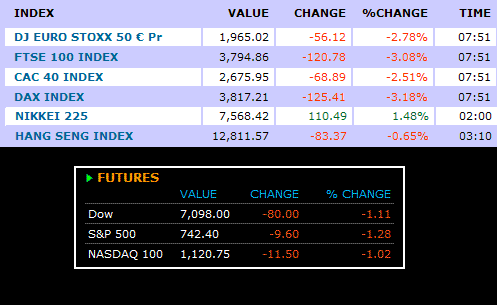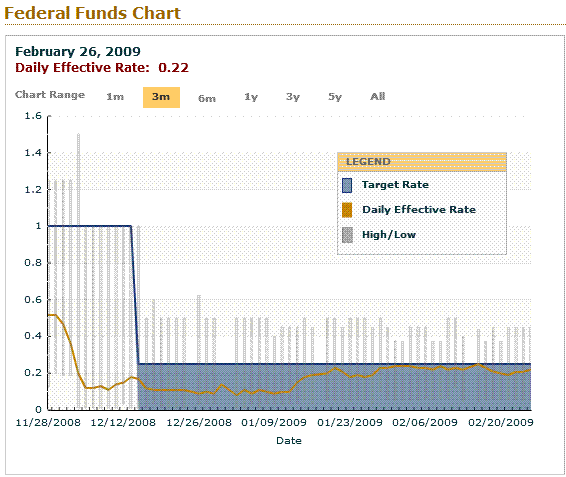At the open...
FN30_____________________________________
FN 4.0 -------->>>> -0-02 to 98-09 from 98-11
FN 4.5 -------->>>> +0-01 to 100-12 from 100-11
FN 5.0 -------->>>> +0-02 to 101-26 from 101-24
FN 5.5 -------->>>> +0-01 to 102-15 from 102-14
FN 6.0 -------->>>> +0-00 to 103-09 from 103-09
GN30______________________________________
GN 4.0 -------->>>> +0-04 to 98-17 from 98-13
GN 4.5 -------->>>> +0-01 to 100-15 from 100-14
GN 5.0 -------->>>> +0-01 to 102-01 from 102-00
GN 5.5 -------->>>> +0-02 to 102-23 from 102-21
GN 6.0 -------->>>> +0-01 to 103-11 from 103-10



Yesterday Moody's Investors Service announced....
from the press release
"that it is raising its loss expectations for US subprime residential mortgage-backed securities (RMBS) issued between 2005 and 2007. As a result, it has placed 7,942 tranches of subprime RMBS with an original balance of $680 billion, on review for possible downgrade.
The revised loss projection for 2006 vintage subprime pools is expected to fall within the range of 28% to 32% of the original balance of such pools, whereas Moody's previous estimate was 22%. For 2005 and 2007 pools, such projections are expected to range from 12% to 14% and 33% to 37% of original balance, respectively.
Moody's attributes the higher loss expectations to the continued deterioration in home prices, rising loss severities on liquidated loans, persistent elevated default rates, and progressively diminishing prepayment rates throughout the sector. The updated projections will reflect current home price projections from Moody's Economy.com. The Homeowner Affordability and Stability Plan (the "Homeowner Plan"), first announced February 18th with specific guidelines expected to be released on March 4th, is expected to have a mitigating impact on Moody's loss estimates. Moody's has formed a preliminary estimate of the impact of the Homeowner Plan and included that estimate in the numbers discussed in this press release, recognizing that our estimate could change when additional detail becomes available next week.
Moody's loss projections will be calculated in three stages. First, we project delinquency rates and eventual losses during the period through late 2009, when we anticipate that home prices will reach bottom in many parts of the US. This is done assuming no government intervention or concerted industry-wide modification effort. Second, still assuming no intervention, losses are projected for the remaining life of a deal. In this no-intervention case, Moody's expectation for the 2006 vintage is that projected losses would reach 33% of the original balance. Under such conditions, Moody's would expect existing subprime loans to default at a rate of 72%, with loss severities on liquidated properties of 70% on average. Parallel projections for 2005 and 2007 would be losses of 14% and 40% of original securitized balances, respectively. The third stage of the deal-specific analysis quantifies the anticipated impact of loan modifications and other aspects of government support under the Homeowner Plan.
Currently, 42% of outstanding 2006-vintage subprime loans are at least 60 days delinquent, in foreclosure, or held for sale (REO). Moody's believes that, without intervention, nearly all of the already-delinquent loans will eventually default. This assessment is based on very high current observed roll rates to foreclosure combined with increasing unemployment and decreasing property values. In addition, Moody's believes that, by year end, one-third of borrowers who are currently paying on their mortgages will become delinquent and eventually default (representing 19% of today's outstanding loans). This projection is based on loan-level analysis of the mortgages, including forecasted loan-to-value ratios (LTVs) for the end of 2009. The LTV ratios were determined by using projections from Moody's Economy.com for metropolitan statistical areas (MSAs). In addition, other predictive metrics such as loan type, occupancy status and documentation level were considered in the analysis.
Despite anticipating modest recovery in the housing environment in the next few years, Moody's expects subprime borrowers will find limited refinancing opportunities due to negative equity and lack of available credit. Moody's projects that an additional 22% of today's non-delinquent loans would default after 2009 (representing 13% of outstanding loans). This, when added to the defaults anticipated from both existing delinquencies and delinquencies expected by year-end, would lead to the overall default rate of 72% discussed above.
Loss severities have also worsened in the last few months, rising to 63%. Moody's is anticipating loss severities to rise to around 70%, based on an expected further 10-15% decline in home values. Even as the housing market boomed in recent years, subprime loss severities increased with loan age. This is generally attributable to accrual of servicer advances and declines in property condition associated with lengthened foreclosure timelines. The likelihood of similar issues persisting in the future leads Moody's to conclude that, despite the anticipated recovery in the housing market, subprime severities are likely to remain elevated over time.
As noted above, Moody's will likely temper its loss expectations discussed in the preceding paragraphs in light of the Homeowner Plan. We anticipate that final subprime loss projections will be reduced from the 33% no-intervention case outlined above to the area of 28% to 32% for the 2006 vintage, depending on additional details of the government's plans.
The announced reviews impact all ratings within the subprime RMBS sector currently rated Ca and above. The ratings of senior bonds that are highly likely to be paid in full in the near term are expected to be confirmed when rating actions are taken. The same may also be true for bonds with structural mitigants relative to the revised loss expectation.
The anticipated actions will vary by vintage, but based on our anticipated average loss projections, it is likely that the vast majority of mezzanine and subordinate certificates currently rated B or above would be downgraded to ratings of Caa or below, particularly for bonds issued in 2006 and 2007. As noted above, actions on senior bonds will differ based on payment priority and protection relative to projected losses. Given the level of losses currently being projected, a majority of senior certificates will likely be downgraded below investment grade. Many are expected to be downgraded to Caa or below, particularly longer duration bonds from 2006 and 2007.
http://www.mortgagenewsdaily.com/mortgage_rates/blog/55591.aspx





